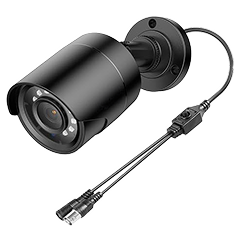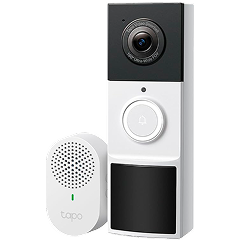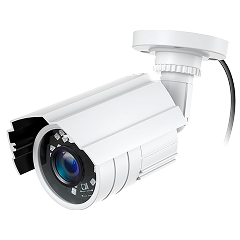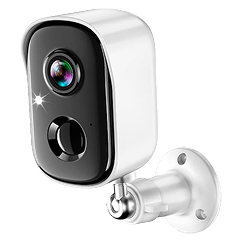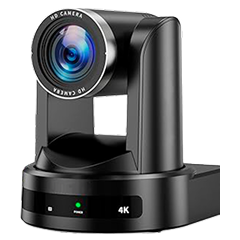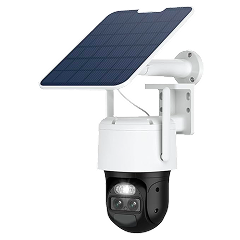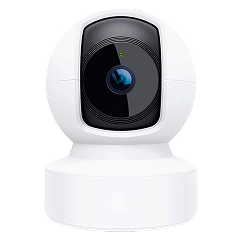Il y a quelques années, j’ai installé des caméras de surveillance extérieur sans fil Ring tout autour de ma maison. En planifiant un futur passage à un système UniFi, j’ai réalisé que les caméras extérieures subissent des problèmes que les modèles d’intérieur ne connaissent pas.
Ma caméra de porte d’entrée a survécu à deux hivers rigoureux et à la chaleur estivale de 35°C, mais l’exposition aux UV a lentement transformé son boîtier noir en gris. Fort de mon expérience d’ingénieur en climatisation, j’ai identifié les défaillances réelles que les fabricants évoquent rarement : la condensation interne dans les boîtiers scellés, la dilatation thermique des supports, ou encore les variations saisonnières de lumière qui perturbent la détection de mouvement.
Ce guide aborde les considérations propres à l’extérieur que les conseils généraux sur les caméras de sécurité oublient souvent. J’y aborde les spécifications techniques essentielles aux installations extérieures, les réalités de l’étanchéité que j’ai apprises à mes dépens, ainsi que les raisons qui me poussent à passer prochainement aux caméras UniFi filaires, après avoir atteint les limites des modèles de caméra de surveillance extérieur sans fil. Pour des bases plus générales sur les caméras de sécurité, comme une vue d’ensemble des marques disponibles et des standards de résolution de base, jetez un œil à notre guide principal.
Caractéristiques essentielles de performance en extérieur
Les caméras de surveillance extérieur sans fil sont confrontées à des exigences techniques que les modèles intérieurs ne rencontrent jamais, allant de l’exposition à des conditions météorologiques extrêmes, aux difficultés d’identification sur de plus longues distances.
Résolution vidéo pour l’identification en extérieur
Installer des caméras de surveillance extérieur sans fil m’a appris que les besoins en résolution diffèrent radicalement de ceux de l’intérieur. Ma caméra de sonnette vidéo Ring 1080p identifie clairement les visages à 4 mètres, mais peine à lire les plaques d’immatriculation au-delà de 6 mètres, même avec un bon éclairage. Le passage au 4K semble intéressant, jusqu’à ce que l’on réalise qu’elle triple la consommation de bande passante et épuise les batteries 40% plus rapidement, d’après mon expérience.
Le zoom numérique devient inutile en extérieur, où il faut identifier des sujets à de plus grandes distances. Mes caméras Ring utilisent un zoom numérique qui se contente d’agrandir les pixels, donc un visage méconnaissable à 9 mètres ne devient pas miraculeusement net en zoomant. La compression aggrave ce problème : l’encodage H.264 supprime des détails pour réduire la taille des fichiers lors de la transmission sans fil, ce qui fait apparaître les sujets éloignés comme des amas de pixels flous.
Portée et performance de la vision nocturne
Les performances de la vision nocturne varient énormément d’un modèle extérieur à l’autre, et le nombre de LED ne dit rien sur la portée réelle. Mes caméras Ring avec projecteur annoncent une vision nocturne de 9 mètres avec huit LED infrarouges, mais je n’obtiens des images exploitables pour l’identification qu’à moins de 6 mètres. Au-delà, les visages deviennent des silhouettes sombres sur des arrière-plans granuleux.
Le positionnement des LED est toujours plus important que leur nombre. Lorsque les lumières infrarouges entourent l’objectif, l’éclairage est uniforme. Lorsqu’elles sont regroupées d’un seul côté, on obtient des zones surexposées et des ombres marquées. La vision nocturne en couleur semble impressionnante dans les démonstrations YouTube, mais n’est pas à la hauteur dans l’obscurité totale. Elle a besoin de l’éclairage public ou d’une lumière de porche pour fonctionner, ce qui la rend inutile dans le noir complet.
Indices de résistance aux intempéries
Les indices IP des caméras extérieures comptent moins que l’emplacement de montage et la qualité de l’installation. Mes caméras Ring IP65 ont parfaitement survécu à trois hivers lorsqu’elles étaient placées sous des avant-toits, tandis que j’ai vu des modèles IP67 tomber en panne lorsqu’ils étaient exposés directement aux intempéries. Ces indices supposent une installation parfaite avec des connexions correctement scellées, ce qui est rarement le cas dans des environnements extérieurs réels.
Les températures extrêmes endommagent les caméras plus rapidement que l’eau. Trois étés en plein soleil ont rendu les boîtiers de mes caméras cassants, et la vague de froid de l’hiver dernier a provoqué de la condensation à l’intérieur d’une unité malgré son indice IP65. La chaleur fait également fondre les adhésifs de montage. Le support de panneau solaire de mon ancienne maison s’est desserré pendant une canicule à 38°C, produisant des images tremblantes jusqu’à ce que je le remplace par des fixations mécaniques.
Considérations techniques propres à l’extérieur
Les spécifications techniques importantes en intérieur deviennent secondaires face aux facteurs environnementaux lorsque les caméras sont exposées en permanence aux éléments extérieurs.
Champ de vision pour la couverture extérieure
Les objectifs grand-angles posent plus de problèmes en extérieur qu’ils n’en résolvent. Mes caméras Ring ont un champ de vision de 110 degrés, ce qui semble complet, jusqu’à ce que l’on réalise que les visages deviennent méconnaissables au-delà de 70 degrés du centre, à cause de la distorsion de l’objectif.
J’ai repositionné ma caméra de porte d’entrée à deux reprises pour essayer de couvrir à la fois le porche et l’entrée de l’allée, mais ma boîte aux lettres crée toujours une zone morte qui bloque une partie de la vue sur la rue. Plusieurs caméras avec des champs de vision plus étroits offrent une meilleure capacité d’identification que quelques modèles grand-angles, même si le coût initial est plus élevé.
L’IA avec détection de mouvement pour les environnements extérieurs
Une détection avancée par intelligence artificielle distingue les caméras de surveillance extérieur sans fil réellement utiles des générateurs de notifications intempestives. Mes caméras Ring combinent des capteurs thermiques PIR à de la vision par ordinateur, réduisant les fausses alertes causées par les voitures qui passent, les arbres qui bougent ou les changements de luminosité qui perturbent les systèmes de détection de mouvement basiques.
La détection de personnes par l’IA fonctionne bien en plein jour, mais a du mal après la tombée de la nuit. Je reçois toutefois encore de temps à autre des alertes provoquées par des chats, que le système prend pour des humains. Le réglage précis des zones de détection m’a pris des mois d’ajustements afin d’exclure le bord éloigné de mon allée, où la circulation passante vidait les batteries, à force d’enregistrements constants.
Options d’alimentation pour les installations extérieures
Les caméras extérieures à batterie semblent pratiques jusqu’à l’arrivée de l’hiver. Mes caméras Ring de mon ancienne maison, qui sont vendues avec une autonomie de six mois par charge, tenaient quatre mois au printemps et en automne, trois mois sous la chaleur estivale et à peine deux mois lorsque les températures descendaient sous zéro.
Les panneaux solaires aident, mais ne sont pas la solution miracle que vantent les fabricants. Je vis dans le nord de l’Indiana aux USA : les panneaux solaires fonctionnaient bien d’avril à septembre, mais peinaient à maintenir le niveau de batterie pendant les courtes journées d’hiver souvent nuageuses. Pour les zones extérieures très fréquentées, tirer un câble d’alimentation basse tension s’avère plus fiable que de compter sur les performances variables du chargement solaire.
Stockage et connectivité pour la sécurité extérieure
Les caméras de sécurité extérieures exigent une gestion des données plus robuste, car elles ne peuvent pas compter sur les conditions réseau stables de l’intérieur, et sont davantage exposées aux risques de sabotage ou de dommages.
Stockage local vs cloud pour les caméras extérieures
Le stockage cloud devient un inconvénient pour les caméras de surveillance extérieur sans fil qui doivent continuer à fonctionner lors des pannes d’Internet ou en cas de coupure volontaire de ligne par des intrus. Mes caméras Ring sont devenues totalement inutiles pendant une panne de connexion de six heures.
Elles ne pouvaient ni enregistrer localement, ni envoyer d’alertes, ni permettre la visualisation en direct, malgré une alimentation et une connexion parfaites à mon routeur. Le stockage local via des systèmes NVR ou des cartes SD assure un enregistrement de secours en cas de perte de connectivité, mais la plupart des caméras extérieures sans fil poussent vers des abonnements cloud mensuels, car la configuration du stockage local réduit leur côté « prêt à l’emploi ».
Exigences réseau pour les caméras de sécurité extérieures
Vous devrez choisir entre une bonne couverture de sécurité et un signal Wi-Fi puissant lors du positionnement des caméras extérieures.
- Limites de portée du Wi-Fi : les murs extérieurs et les matériaux de construction réduisent la puissance du signal de 30 à 50% par rapport aux installations intérieures.
- Concurrence sur la bande passante : plusieurs caméras extérieures enregistrant en même temps peuvent saturer la vitesse de téléversement (upload) d’une connexion domestique pendant les heures de fort trafic Internet.
- Solutions de réseau maillé : j’ai ajouté un point d’accès Wi-Fi dans mon garage spécialement pour ma caméra éloignée, ce qui a résolu les coupures de connexion qui gênaient l’installation initiale.
- Test de vitesse de téléversement : testez la vitesse de téléversement réelle à chaque emplacement prévu pour une caméra, pas seulement la vitesse de téléchargement. De nombreux forfaits Internet ont une bande passante asymétrique qui affecte la qualité d’enregistrement.
- Planification de la congestion réseau : mes caméras enregistrent correctement pendant la journée, mais deviennent saccadées entre 19h et 22h lorsque les membres de la famille regardent des vidéos en streaming.
Installation et montage pour une utilisation en extérieur
L’installation de caméras extérieures nécessite des solutions de fixation permanentes capables de résister aux conditions météorologiques extrêmes et aux tentatives de sabotage.
La quincaillerie de montage devient le point faible de la plupart des installations extérieures. Les chevilles en plastique fournies avec les caméras se sont arrachées du mur en parpaings de mon garage lors de la première tempête, m’apprenant que le montage extérieur exige du matériel solide et durable…
Le béton et la brique nécessitent des forets pour maçonnerie et des chevilles à expansion, tandis que le bardage en vinyle exige des plaques de support pour bien répartir le poids. Je teste toujours la solidité du support avant l’installation finale. Une caméra qui résiste à la pression de la main ne supportera pas forcément les rafales de vent ou la dilatation thermique.
Un positionnement stratégique doit équilibrer la couverture de sécurité et les contraintes d’installation. Ma plus grosse erreur a été de monter d’abord les caméras aux emplacements les plus sécurisés, pour ensuite découvrir que le signal Wi-Fi y était trop faible, entraînant des déconnexions constantes. J’ai ajouté un point d’accès Wi-Fi plus proche des caméras problématiques, plutôt que d’accepter des angles de couverture compromis.
L’installation professionnelle peut être préférable pour les caméras placées en hauteur ou dans des zones où le Wi-Fi passe mal. Les installateurs facturent environ 80 à 180 € par caméra, mais apportent les bons ancrages, une expertise en étanchéité et une assurance que les assurances habitation classiques n’incluent pas.
Une gestion étanche des câbles évite bien des soucis de maintenance à l’avenir. Même les caméras de surveillance extérieur sans fil nécessitent des connexions d’alimentation résistantes aux intempéries pour les modèles filaires ou à panneaux solaires. J’ai appliqué du mastic silicone autour de chaque entrée de câble après avoir découvert des infiltrations d’eau à l’intérieur de mon premier support de montage.
Intégration et fonctionnalités intelligentes
Les caméras de surveillance extérieur sans fil sont idéales lorsqu’elles s’intègrent facilement à votre équipement domotique et à votre système de sécurité existants.
Intégration domotique pour la sécurité extérieure
La compatibilité avec la maison connectée devient encore plus importante pour les caméras de surveillance extérieur sans fil, puisqu’elles déclenchent souvent des actions automatisées comme l’allumage de lumières ou les alarmes. Mes caméras Ring s’intègrent bien avec Alexa, affichant automatiquement le flux en direct sur les écrans Echo Show lorsqu’un mouvement est détecté, mais elles fonctionnent moins bien avec les écosystèmes Google ou Apple.
La qualité de l’audio bidirectionnel varie énormément selon les marques. Les haut-parleurs Ring suffisent pour dissuader les voleurs de colis, tandis que les modèles bon marché produisent un son métallique à peine compréhensible en extérieur, où le vent et la circulation génèrent beaucoup de bruit de fond.
L’écosystème des marques
Les fabricants de caméras vous enferment dans leur écosystème, rendant le passage à une autre marque coûteux et compliqué.
Ring vous oblige à utiliser les appareils Alexa et Echo d’Amazon, tandis que le passage à UniFi que je prévois fonctionnera avec Home Assistant, pour une automatisation complexe que la plupart des gens ne prendront pas le temps de configurer. Les abonnements pèsent plus lourd dans le budget pour les caméras extérieures, car il faut davantage d’unités pour couvrir toute la propriété, ce qui rend les frais par caméra rapidement coûteux.
Analyse du budget et du rapport qualité-prix
Les dépenses liées aux caméras de surveillance extérieur sans fil vont bien au-delà du prix affiché, car l’exposition aux éléments augmente la fréquence de remplacement et les coûts d’abonnement s’accumulent avec le nombre de caméras nécessaires à la couverture du terrain. Mon système Ring m’a coûté 1 100 € sur trois ans, tandis que le passage à UniFi que je prévois coûte 1 400 € à l’achat, mais supprime complètement les frais mensuels.
L’installation professionnelle ajoute environ 90 à 180 € par caméra pour le montage extérieur, mais inclut une étanchéité correcte et une couverture d’assurance que les installations faites soi-même n’offrent pas. Les systèmes sans abonnement demandent plus de compétences techniques et un investissement initial plus élevé, mais ils s’amortissent en 18 à 24 mois si vous êtes capable de configurer le réseau vous-même.
Erreurs courantes avec les caméras extérieures
Voici les erreurs qui m’ont coûté du temps, de l’argent ou une couverture de sécurité pendant mes trois années d’expérience avec les caméras extérieures.
- Sous-estimer la portée du Wi-Fi à travers les murs extérieurs : l’emplacement de ma caméra de garage semblait parfait pour la couverture, mais subissait des déconnexions constantes, jusqu’à ce que j’ajoute un point d’accès dédié.
- Régler excessivement la sensibilité du mouvement : j’ai augmenté la sensibilité en pensant que plus d’alertes signifiait plus de sécurité, mais j’ai fini avec plus de 50 notifications quotidiennes causées par des ombres et des insectes, au point d’ignorer complètement l’application.
- Ignorer les variations saisonnières des performances de la batterie : j’ai planifié la maintenance selon l’autonomie estivale, puis me suis retrouvé avec des caméras à plat en hiver, lorsque la consommation de batterie doublait.
- Monter les caméras trop haut pour identifier les visages : ma caméra du côté de la maison, installée à 3,5 mètres, offre une excellente vue d’ensemble du terrain, mais ne permet pas d’identifier clairement les visages pour les rapports de police.
- Supposer que les panneaux solaires fonctionnent toute l’année : je les ai installés en été, pensant avoir réglé le problème de la recharge à jamais, pour découvrir qu’ils fonctionnent à peine pendant les courtes journées d’hiver.
- Ne pas tester la qualité d’enregistrement en soirée : mes caméras fonctionnent parfaitement toute la journée, puis les flux deviennent hachurés entre 19h et 22h quand ma famille commence à regarder Netflix.
Comment choisir le bon système de caméras de surveillance extérieur pour votre maison
Choisissez vos caméras extérieures en fonction de votre niveau de technicité et de vos objectifs à long terme. Vous recherchez une installation simple sans vous soucier des frais mensuels ? Ring ou Arlo fonctionnent de manière fiable pour la plupart des utilisateurs, même si, au bout de quelques années, les coûts d’abonnement dépassent le prix du matériel.
Si vous êtes prêts à investir de votre temps pour apprendre, des systèmes tels que Reolink ou UniFi offrent un meilleur rapport qualité-prix et un meilleur contrôle de la confidentialité, mais attendez-vous à passer un ou deux week-ends à résoudre des problèmes, configurer le réseau et paramétrer les fonctionnalités avancées.
Commencez avec moins de caméras que vous pensez en avoir besoin, testez-les sur différentes saisons et conditions météorologiques, puis élargissez votre installation une fois que vous saurez ce qui fonctionne le mieux pour votre propriété. Mon système Ring a rempli son rôle comme solution de sécurité rapide, mais après trois ans de frais d’abonnement et de limitations liées à l’écosystème, je passe bientôt à l’installation UniFi, plus complexe mais bien plus performante.
Les caméras avec abonnement s’installent rapidement et sans trop de soucis techniques, tandis que les systèmes réseau faits maison demandent plus d’efforts, mais offrent de meilleures performances à long terme et un contrôle total sur vos données.


